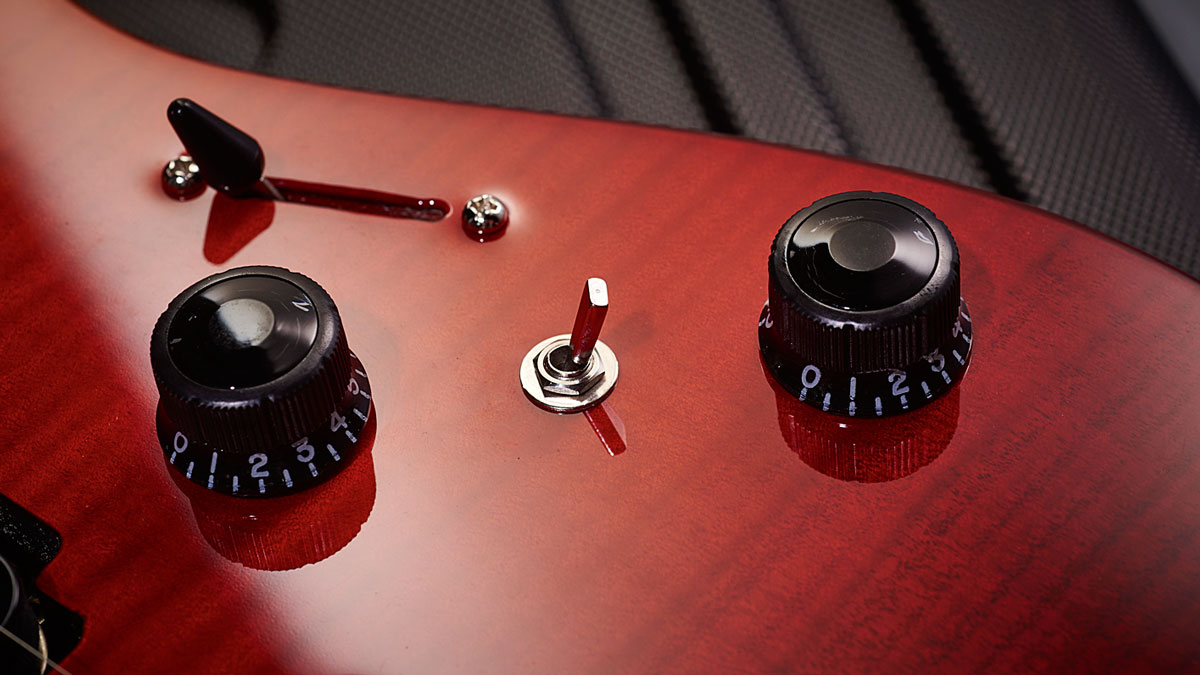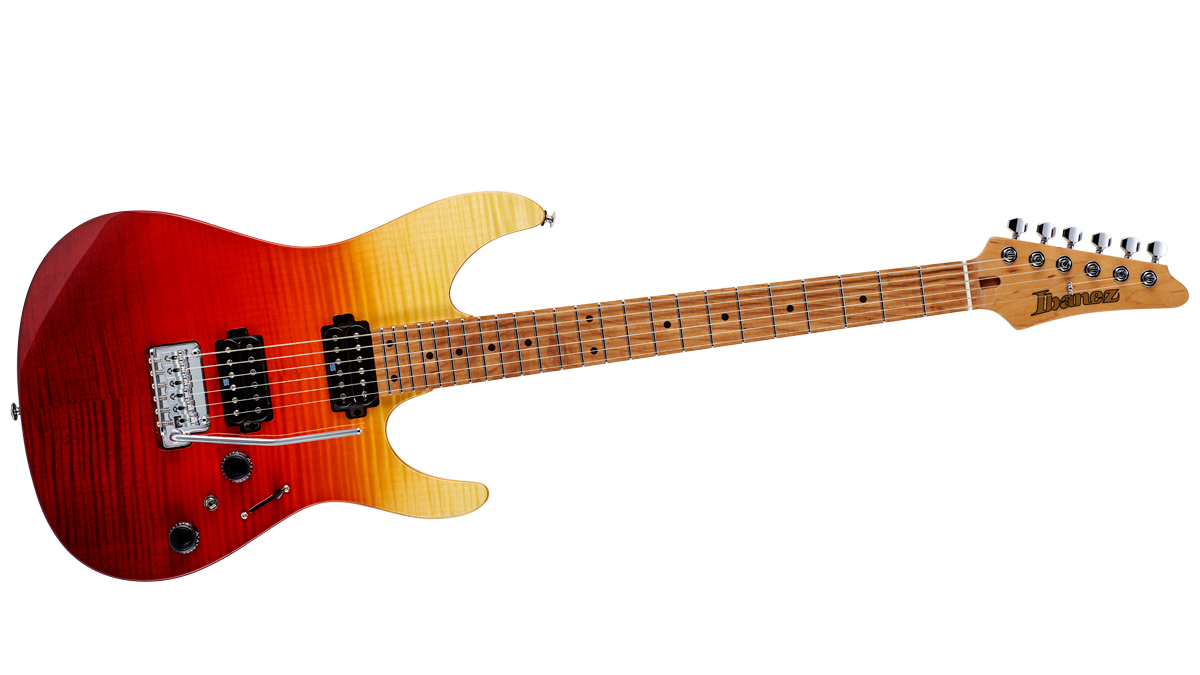MusicRadar Verdict
If you dig the finish, this is one superbly put-together double-cut.
Pros
- +
Superb engine and sound.
- +
Excellent playability.
Cons
- -
No rosewood or leftie option.
MusicRadar's got your back
By design, the AZ series is all about function: a tool to do a job.
That said, both the body and neck adopt a more vintage bolt-on guise that’s less pointy, more classic than we’re used to from Ibanez. The body contour here, especially the rib-cage cut, is very deep and although the edge radius is pretty tight these are comfortable, familiar guitars.
All the recently-released AZs, as you’d expect, are based around the classic 648mm (25.5-inch) bolt-on scale length. There are both 22- and 24-fret models in both Prestige and Premium lines: the 22-fret models have an HSS pickup configuration and a Strat-meets-RG-style scratchplate; the 24-fret models have dual direct-mount humbuckers with no scratchplate and rear-mounted electronics. Bridge positions are the same on both 22/24-fret platforms, the 24-fret neck therefore sits slightly deeper into the body and as a result the treble cutaway is slightly deeper, too. Here, we’re looking at the Premium AZ242F-TSG.
The guitar uses the heavily rounded ‘All Access’ body heel with four recessed screws that sit into inset washers; the heel area is slightly thinner in depth than the rest of the body and both cutaways have quite considerable scooping on the back, not the front. High fret access is easy.
Roasted maple is becoming the neck wood of choice for those serious about their bolt-ons. This model uses roasted maple, which has a lighter colour (and on the AZ224F a very vivid grain) that’s still darker than untorrefied wood. Material aside, the necks are spec’d with an ‘oval C’ profile, a standard 305mm (12-inch) Gibson-like radius and jumbo stainless steel frets. Nuts are Graph Tech Tusq XL.

The tuner is Gotoh’s SG381 with both height adjustable posts (HAP) and Magnum Locks. The former allow you set the post heights to maximize the string angle behind the nut although Ibanez still uses a string tree on the top two strings while the locking element self-locks as you wind on the string and unlocks - usually with a little help from a blade or coin in the top notched tip - as you unwind it. Once you get used to ’em they’re fine but both the locking element and setting the post heights can be, well, fiddly at first.
The vibrato bridge is based on Gotoh’s ‘modern classic’ 510 with two height adjustable and lockable pivot posts, plus a new-design knurled collar to tension the push-fit vibrato arm. The Premium’s T1502 uses plated steel saddles and a tapered die-cast FST block, which has deep drilled anchor holes. Spacing is quoted on both as 10.5mm - which should mean an E-to-E string spread of 52.5mm when in fact on all four it measures bang on 52mm at the saddle’s break point. The vibratos sit virtually flush with the guitars’ top face but a recess underneath means travel, especially upbend, is enhanced without having to tilt the unit.
Pickups and Control
Having gone to so much detail it’s little surprise we have a completely new set of AZ-exclusive pickups: Seymour Duncan Hyperion designed collaboratively, we’re told, with Duncan’s Maricela ‘MJ’ Juarez.
This HSS guitar has the dyna-MIX 9 system introduced by a two-way mini-toggle ‘Alter’ switch placed between the master volume and tone controls. In position 1 (towards the tone control) we get the usual selections from the five-way: neck, neck and middle, middle, middle and slug coil of the bridge humbucker and, lastly, the full bridge humbucker. Flip the Alter switch towards the volume control, however, and we get four additional sounds: neck and middle in series, neck and screw coil of the bridge humbucker in parallel, neck and middle in series plus the bridge humbucker added in parallel, the slug coil of the bridge humbucker and, once again, the bridge humbucker.
Another performance consideration is the placement of the output jack - on the guitar’s side, by the lower wide flange strap button, and angled so you thread your lead through your strap to secure it more easily.
Feel and sounds
Ibanez’s RG might rightly be one of the relatively few modern classic designs but its thin-depthed, wide and flat neck isn’t for everyone, not least those of us that like more traditional bolt-ons. While the spec, for example, on the Super Wizard HP - “the neck for shredders,” states Ibanez - offers a 17mm depth at the first fret, 19mm by the 12th with a nut with of 43mm and a ’board radius of 430mm (16.9"), the AZ’s neck is much more conventional measuring between 41.84mm to 42.38mm at the nut, 20.5 to 21mm at the 1st fret and between 23mm and 23.2mm at the 12th.
The ’board radius is rounder too and puts the AZ much more in line with modern Fender or Suhr. Neck relief, as supplied, is minimal. In terms of oil finish, the Premium has a light sealer coat. They don’t feel quite as slinky as, for example, Music Man. A quick rub with a fine Scotch-Brite pad made them feel very satin- smooth.
The modern/vintage vibe certainly continues to the actual sound. This guitar does not have an overly resonant response: it’s quite firm but with oodles of zingy sustaining ring that’s a noticeable contrast to the woodier unplugged response of the more traditional vintage-y bolt-ons we have for comparison.
Getting your head around the sound options takes a little practice. As we said, the ‘standard’ mode is with that two-way Alter switch pointing down towards the tone control and with the bridge humbuckers measuring around 14.8k ohms (the neck ’bucker measures approximately 9k ohms), the single coils just over 10k ohms, these
are far from vintage spec. The humbuckers impart a thick but not overly dark voice;
the single coils, despite that overwound reading, sound full but nicely contrasting and well-balanced in context.
Hugely interesting, this AZ model might well surprise many players who’ve pigeon-holed Ibanez as shred guitars for the masses
With no proper single coils, the 24-fret dual humbucker format models would seem to move away from Fender-like voicings. If we’re honest, a three-way switch for just the humbuckers would make this a hugely valid rock machine but there are another seven sounds to explore from the inner or outer single coils, to the solo slug and screw coils of the neck and bridge respectively. These sound a little thinner and brighter than the 22-fretters’ proper single coils but again, in context, they add huge stylistic versatility.
And then there are the ‘Power Tap’ voicings of either humbucker or both together. Now these don’t capture a ‘true’ single coil voice - we already have those. No, these PT voicings sit somewhere between a single coil and humbucker. There’s slightly more single coil-like hollowness compared to the full ’bucker’s direct power yet still with considerable humbucker depth.
Clean they benefit from a little volume roll-off - there’s even a hint of a Rickenbacker’s unique growl - while gained they provide another texture, especially so at the bridge. Indeed, in this secondary mode a different guitar emerges and having the solo single coils in the mix positions - then simply switching the Alter switch to introduce the inner or outer single coil mixes - gives immense Fendery flavour that’s far from the clichéd image of the none-more-rock RG.
This affordable Premium guitar has many of the hallmarks of the recently-reviewed Prestige models, although it does sound a little softer, slightly less percussive and bold especially on those more single coil-y voices. For high gain settings, basswood has its credentials and if that’s your sole sonic aim then you could save yourself a large wedge of cash. But the AZ design is about covering more bases and the alder-bodied Prestige models, to our ears at least, sound more ‘grown-up’.
The vibrato system is impressive. Sure, you can’t deck the vibrato as many prefer but then that falls into more traditional bolt-on territory: don’t forget, this is still an Ibanez guitar through and through.
Hugely interesting, this AZ model might well surprise many players who’ve pigeon-holed Ibanez as shred guitars for the masses.
Dave Burrluck is one of the world’s most experienced guitar journalists, who started writing back in the '80s for International Musician and Recording World, co-founded The Guitar Magazine and has been the Gear Reviews Editor of Guitarist magazine for the past two decades. Along the way, Dave has been the sole author of The PRS Guitar Book and The Player's Guide to Guitar Maintenance as well as contributing to numerous other books on the electric guitar. Dave is an active gigging and recording musician and still finds time to make, repair and mod guitars, not least for Guitarist’s The Mod Squad.
“We were arguing a lot and we were miserable”: How Green Day exceeded expectations with their most ambitious song
"There’s plenty for us guitarists to learn – and ‘less is more’ is the overriding lesson": how to play like George Harrison on The Beatles' Abbey Road
“They didn’t like his bikini underwear”: Prince’s support sets for the The Rolling Stones in 1981 are remembered as disastrous, but guitarist Dez Dickerson says that the the crowd reaction wasn’t as bad as people think











